写的很好的一篇LINUX下USB设备检测的文章
2015-04-24 12:08
197 查看
This article, which is part of theseries
on Linux device drivers, gets you started with writing your first USB driver in Linux.
Pugs’ pen drive was the device Shweta was playing with, when both of them sat down to explore the world of USB drivers in Linux. The fastest way to get the hang of it, and Pugs’ usual way, was to pick up a USB device, and write a driver for it, to experiment
with. So they chose a pen drive (a.k.a. USB stick) that was at hand — a JetFlash from Transcend, with vendor ID
product ID
Whether a driver for a USB device is there or not on a Linux system, a valid USB device will always be detected at the hardware and kernel spaces of a USB-enabled Linux system, since it is designed (and detected) as per the USB protocol specifications. Hardware-space
detection is done by the USB host controller — typically a native bus device, like a PCI device on x86 systems. The corresponding host controller driver would pick and translate the low-level physical layer information into higher-level USB protocol-specific
information. The USB protocol formatted information about the USB device is then populated into the generic USB core layer (the usbcore driver) in kernel-space, thus enabling the detection of a USB device in kernel-space, even without having its specific driver.
After this, it is up to various drivers, interfaces, and applications (which are dependent on the various Linux distributions), to have the user-space view of the detected devices. Figure 1 shows a top-to-bottom view of the USB subsystem in Linux.
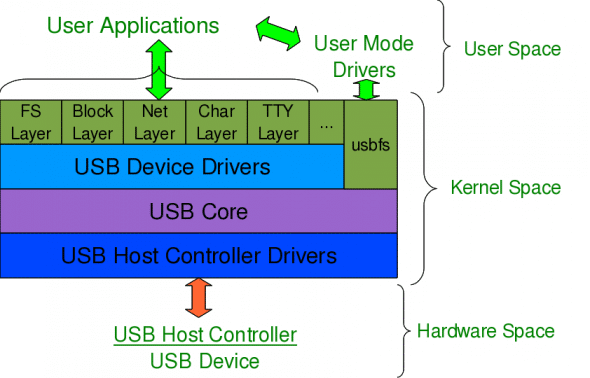
Figure 1: USB subsystem in Linux
A basic listing of all detected USB devices can be obtained using the
Figure 2 shows this, with and without the pen drive plugged in. A
detailed information.
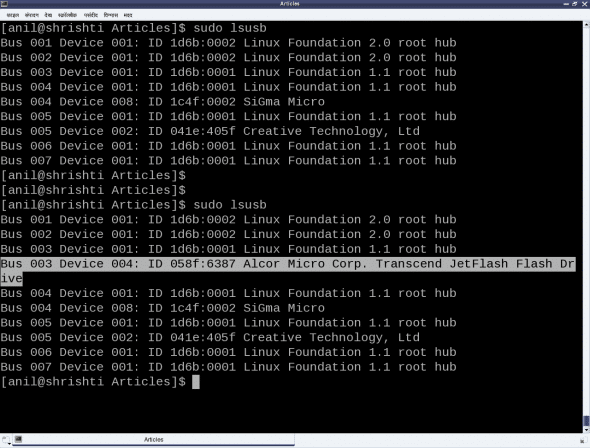
Figure 2: Output of lsusb
In many Linux distributions like Mandriva, Fedora,… the
the default configuration. This enables the detected USB device details to be viewed in a more techno-friendly way through the
using
the pen drive-specific section. The listing basically contains one such section for each valid USB device detected on the system.
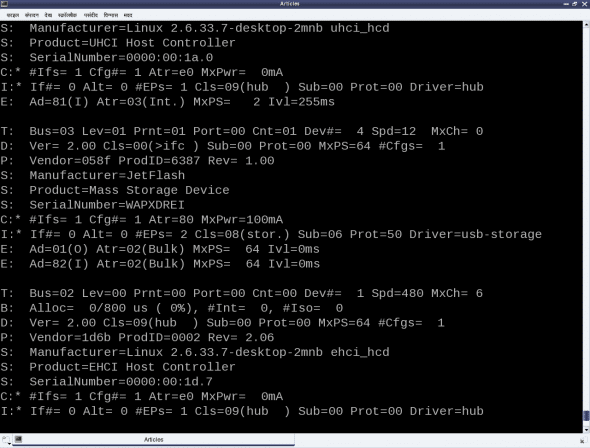
Figure 3: USB's proc window snippet
To further decode these sections, a valid USB device needs to be understood first. All valid USB devices contain one or more configurations. A configuration of a USB device is like a profile, where the default one is the commonly used one. As such, Linux supports
only one configuration per device — the default one. For every configuration, the device may have one or more interfaces. An interface corresponds to a function provided by the device.
There would be as many interfaces as the number of functions provided by the device. So, say an MFD (multi-function device) USB printer can do printing, scanning and faxing, then it most likely would have at least three interfaces, one for each of the functions.
So, unlike other device drivers, a USB device driver is typically associated/written per interface, rather than the device as a whole — meaning that one USB device may have multiple device drivers, and different device interfaces may have the same driver —
though, of course, one interface can have a maximum of one driver only.
It is okay and fairly common to have a single USB device driver for all the interfaces of a USB device. The
in the
no associated driver.
For every interface, there would be one or more end-points. An end-point is like a pipe for transferring information either into or from the interface of the device, depending on the functionality. Based on the type of information, the endpoints have four types:
Control, Interrupt, Bulk and Isochronous.
As per the USB protocol specification, all valid USB devices have an implicit special control end-point zero, the only bi-directional end-point. Figure 4 shows the complete pictorial representation of a valid USB device, based on the above explanation.
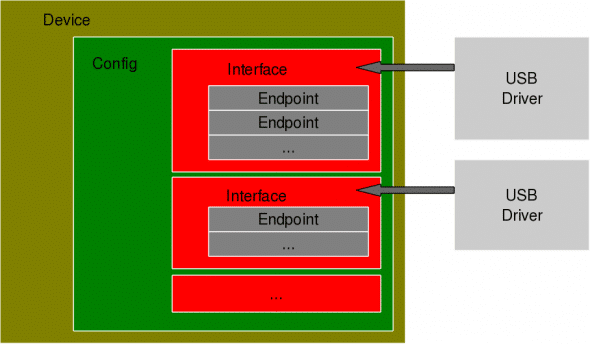
Figure 4: USB device overview
Coming back to the USB device sections (Figure 3), the first letter on each line represents the various parts of the USB device specification just explained. For example, D for device, C for configuration, I for interface, E for endpoint, etc. Details about
these and various others are available in the kernel source, in
“Seems like there are so many things to know about the USB protocol, to be able to write the first USB driver itself — device configuration, interfaces, transfer pipes, their four types, and so many other symbols like T, B, S, … under a USB device specification,”
sighed Shweta.
“Yes, but don’t you worry — all of that can be covered in detail later. Let’s do first things first — get the pen drive’s interface associated with our USB device driver (
consoled Pugs.
Like any other Linux device driver, here, too, the constructor and the destructor are required — basically the same driver template that has been used for all the drivers. However, the content would vary, as this is a hardware protocol layer driver, i.e., a
horizontal driver, unlike a character driver, which was one of the vertical drivers discussed earlier. The difference would be that instead of registering with and unregistering from VFS, here this would be done with the corresponding protocol layer — the
USB core in this case; instead of providing a user-space interface like a device file, it would get connected with the actual device in hardware-space.
The USB core APIs for the same are as follows (prototyped in
As part of the
for auto-detecting the particular device, and the two callback functions to be invoked by the USB core during a hot plugging and a hot removal of the device, respectively.
Putting it all together,
Then, the usual steps for any Linux device driver may be repeated:
Build the driver (
Load the driver using
List the loaded modules using
Unload the driver using
But surprisingly, the results wouldn’t be as expected. Check
to see the various logs and details. This is not because a USB driver is different from a character driver — but there’s a catch. Figure 3 shows that the pen drive has one interface (numbered 0), which is already associated with the usual usb-storage driver.
Now, in order to get our driver associated with that interface, we need to unload the usb-storage driver (i.e.,
snippet. Repeat hot-plugging in and hot-plugging out the pen drive to observe the probe and disconnect calls in action.
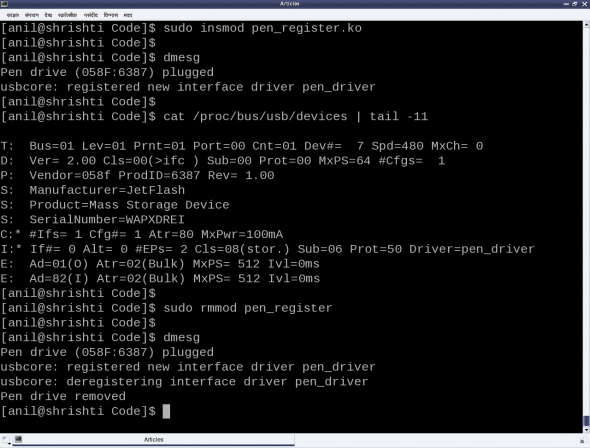
Figure 5: Pen driver in action
“Finally! Something in action!” a relieved Shweta said. “But it seems like there are so many things (like the device ID table, probe, disconnect, etc.), yet to be understood to get a complete USB device driver in place.”
“Yes, you are right. Let’s take them up, one by one, with breaks,” replied Pugs, taking a break himself.
on Linux device drivers, gets you started with writing your first USB driver in Linux.
Pugs’ pen drive was the device Shweta was playing with, when both of them sat down to explore the world of USB drivers in Linux. The fastest way to get the hang of it, and Pugs’ usual way, was to pick up a USB device, and write a driver for it, to experiment
with. So they chose a pen drive (a.k.a. USB stick) that was at hand — a JetFlash from Transcend, with vendor ID
0x058fand
product ID
0x6387.
USB device detection in Linux
Whether a driver for a USB device is there or not on a Linux system, a valid USB device will always be detected at the hardware and kernel spaces of a USB-enabled Linux system, since it is designed (and detected) as per the USB protocol specifications. Hardware-spacedetection is done by the USB host controller — typically a native bus device, like a PCI device on x86 systems. The corresponding host controller driver would pick and translate the low-level physical layer information into higher-level USB protocol-specific
information. The USB protocol formatted information about the USB device is then populated into the generic USB core layer (the usbcore driver) in kernel-space, thus enabling the detection of a USB device in kernel-space, even without having its specific driver.
After this, it is up to various drivers, interfaces, and applications (which are dependent on the various Linux distributions), to have the user-space view of the detected devices. Figure 1 shows a top-to-bottom view of the USB subsystem in Linux.

Figure 1: USB subsystem in Linux
A basic listing of all detected USB devices can be obtained using the
lsusbcommand, as root.
Figure 2 shows this, with and without the pen drive plugged in. A
-voption to
lsusbprovides
detailed information.

Figure 2: Output of lsusb
In many Linux distributions like Mandriva, Fedora,… the
usbfsdriver is loaded as part of
the default configuration. This enables the detected USB device details to be viewed in a more techno-friendly way through the
/procwindow,
using
cat /proc/bus/usb/devices. Figure 3 shows a typical snippet of the same, clipped around
the pen drive-specific section. The listing basically contains one such section for each valid USB device detected on the system.

Figure 3: USB's proc window snippet
Decoding a USB device section
To further decode these sections, a valid USB device needs to be understood first. All valid USB devices contain one or more configurations. A configuration of a USB device is like a profile, where the default one is the commonly used one. As such, Linux supportsonly one configuration per device — the default one. For every configuration, the device may have one or more interfaces. An interface corresponds to a function provided by the device.
There would be as many interfaces as the number of functions provided by the device. So, say an MFD (multi-function device) USB printer can do printing, scanning and faxing, then it most likely would have at least three interfaces, one for each of the functions.
So, unlike other device drivers, a USB device driver is typically associated/written per interface, rather than the device as a whole — meaning that one USB device may have multiple device drivers, and different device interfaces may have the same driver —
though, of course, one interface can have a maximum of one driver only.
It is okay and fairly common to have a single USB device driver for all the interfaces of a USB device. The
Driver=...entry
in the
procwindow output (Figure 3) shows the interface to driver mapping — a
(none)indicating
no associated driver.
For every interface, there would be one or more end-points. An end-point is like a pipe for transferring information either into or from the interface of the device, depending on the functionality. Based on the type of information, the endpoints have four types:
Control, Interrupt, Bulk and Isochronous.
As per the USB protocol specification, all valid USB devices have an implicit special control end-point zero, the only bi-directional end-point. Figure 4 shows the complete pictorial representation of a valid USB device, based on the above explanation.

Figure 4: USB device overview
Coming back to the USB device sections (Figure 3), the first letter on each line represents the various parts of the USB device specification just explained. For example, D for device, C for configuration, I for interface, E for endpoint, etc. Details about
these and various others are available in the kernel source, in
Documentation/usb/proc_usb_info.txt.
The USB pen drive driver registration
“Seems like there are so many things to know about the USB protocol, to be able to write the first USB driver itself — device configuration, interfaces, transfer pipes, their four types, and so many other symbols like T, B, S, … under a USB device specification,”sighed Shweta.
“Yes, but don’t you worry — all of that can be covered in detail later. Let’s do first things first — get the pen drive’s interface associated with our USB device driver (
pen_register.ko),”
consoled Pugs.
Like any other Linux device driver, here, too, the constructor and the destructor are required — basically the same driver template that has been used for all the drivers. However, the content would vary, as this is a hardware protocol layer driver, i.e., a
horizontal driver, unlike a character driver, which was one of the vertical drivers discussed earlier. The difference would be that instead of registering with and unregistering from VFS, here this would be done with the corresponding protocol layer — the
USB core in this case; instead of providing a user-space interface like a device file, it would get connected with the actual device in hardware-space.
The USB core APIs for the same are as follows (prototyped in
<linux/usb.h>):
usb_driverstructure, the fields to be provided are the driver’s name, ID table
for auto-detecting the particular device, and the two callback functions to be invoked by the USB core during a hot plugging and a hot removal of the device, respectively.
Putting it all together,
pen_register.cwould look like what follows:
Build the driver (
.kofile) by running
make.
Load the driver using
insmod.
List the loaded modules using
lsmod.
Unload the driver using
rmmod.
But surprisingly, the results wouldn’t be as expected. Check
dmesgand the
procwindow
to see the various logs and details. This is not because a USB driver is different from a character driver — but there’s a catch. Figure 3 shows that the pen drive has one interface (numbered 0), which is already associated with the usual usb-storage driver.
Now, in order to get our driver associated with that interface, we need to unload the usb-storage driver (i.e.,
rmmod usb-storage) and replug the pen drive. Once that’s done, the results would be as expected. Figure 5 shows a glimpse of the possible logs and a
procwindow
snippet. Repeat hot-plugging in and hot-plugging out the pen drive to observe the probe and disconnect calls in action.

Figure 5: Pen driver in action
Summing up
“Finally! Something in action!” a relieved Shweta said. “But it seems like there are so many things (like the device ID table, probe, disconnect, etc.), yet to be understood to get a complete USB device driver in place.”“Yes, you are right. Let’s take them up, one by one, with breaks,” replied Pugs, taking a break himself.
相关文章推荐
- Linux下C语言来检测USB设备以及自动挂载
- Linux下USB设备的检测
- Linux下USB设备检测
- Linux下C语言来检测USB设备以及自动区分U盘和硬盘并自动挂载
- 很好转《Linux总线、设备与驱动》USB设备发现机制
- 网上看到的一篇很好的讲解linux驱动的文章(适用于2.6以后的内核)
- Linux下USB设备检测
- Linux下USB设备检测
- 一篇很好的讲gentoo linux fcitx 配置的文章
- Linux下USB设备检测
- Linux下USB设备检测
- linux app应用如何检测USB设备热插拔
- 转一篇关于linux设备模型的好文章
- Linux下USB设备检测 .
- Linux下USB设备检测
- Linux 系统USB设备检测
- Linux下USB设备检测
- Linux下USB设备检测
- 看到一篇很好的文章《BEM —— 源自Yandex的CSS 命名方法论》分享下
- 【转】Linux那些事儿 之 戏说USB(22)设备的生命线(一)
